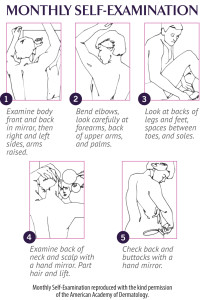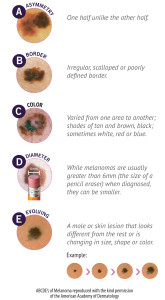Disclaimer :: Dr. Alice Wuu, a local dermatologist, wrote and sponsored this post on mole care and how to know when concern is warranted. Thanks to Dr. Wuu for keeping us informed and prepared!
 As a dermatologist in private practice, one of the most common questions I get asked by parents is, “I’m worried about my child’s moles. Should I bring him in to see you?” Moles in children are very common, and luckily, the vast majority are not dangerous.
As a dermatologist in private practice, one of the most common questions I get asked by parents is, “I’m worried about my child’s moles. Should I bring him in to see you?” Moles in children are very common, and luckily, the vast majority are not dangerous.
Some children are born with a mole as a birthmark, or have one appear in the first year of life, known as a congenital nevus. These are often larger and darker than moles that may appear later in life. Over time, moles may appear on parts of the body that are exposed to the sun, such as the face, torso and arms. Some children have many, and others have very few. The number of moles a child has is often affected by genetics as well. Most moles are small, round, and a single color. They can be either flat or raised, and sometimes one will have hair growing out of it.
I recommend that any child with moles gets a baseline skin exam with a dermatologist. He or she should examine the child head to toe, including the scalp and between the toes, to look for any concerning lesions or the “ugly duckling.” If needed, those can be measured and photographed. Most moles do not need to be surgically removed because they are benign, and would leave a scar as a result. Instead, any concerning moles can be followed with serial photographs, measurements, and exams.
 After an initial skin exam, most children only need to be examined every few years. The exceptions are if the child has numerous large congenital nevi, if any are changing significantly, or if there is a family history of melanoma. I often tell parents that a child’s moles should grow proportionately with him or her as the child gets larger, and not outgrow the child. Sun and hormones can also trigger moles to grow, so oftentimes parents will notice their child’s moles change after the summer or puberty. I encourage patients to perform self-skin exams at home monthly after a bath or shower. Now that cell phone cameras are so ubiquitous, patients can also track their moles by taking a photograph of the mole next to a ruler.
After an initial skin exam, most children only need to be examined every few years. The exceptions are if the child has numerous large congenital nevi, if any are changing significantly, or if there is a family history of melanoma. I often tell parents that a child’s moles should grow proportionately with him or her as the child gets larger, and not outgrow the child. Sun and hormones can also trigger moles to grow, so oftentimes parents will notice their child’s moles change after the summer or puberty. I encourage patients to perform self-skin exams at home monthly after a bath or shower. Now that cell phone cameras are so ubiquitous, patients can also track their moles by taking a photograph of the mole next to a ruler.
In general, moles should be examined by a dermatologist if they are changing significantly in size or shape, have multiple colors, or are persistently bothersome. The commonly used mnemonic is the ABCDEs:
- Asymmetry – If you draw a line through the center of the mole, are both sides equal?
- Border – Can you draw a smooth line around the mole?
- Color – Are there more than two colors (usually light and dark brown) within the mole?
- Diameter – Is the mole greater than six millimeters wide?
- Evolution – Is the mole changing over time?
Last, moles are usually asymptomatic unless rubbed by clothing or scratched, but persistent itch, bleeding, or pain can be a red flag. If you have any concerns about your child’s moles, you should have it examined by a professional.
Living in Texas means we are all exposed to plenty of sun! Children especially have skin that is more vulnerable to UV radiation. Sun protection is a must — not only to prevent sunburn, but also to decrease the chances of moles growing or changing.
Some tips on keeping children safe in the sun:
- Avoid being in the direct sun between the hours of 10:00 a.m. and 2:00 p.m. A general rule of thumb is if your shadow is shorter than you are tall, it’s too early to be outside.
- The “best” sunscreen is the one you wear. Apply SPF 30+ before leaving the house, and reapply every two hours if you’re still out and about. For children, I recommend the chemical-free sunscreens that are available over the counter. Just look for zinc oxide or titanium dioxide on the label. These are often marketed as “for sensitive skin” or “for babies.”
- Wear a hat with a brim at least two inches wide to help shield your face, and sunglasses to help protect your eyes.
- Wear sun shirts and other clothing with UPF 30+ to help block harmful rays. They can be found at sporting goods stores or from online retailers like Coolibar and UV Skinz.
 Dr. Alice Wuu is a board-certified dermatologist practicing in Fort Worth, Texas. She graduated from the Massachusetts Institute of Technology with a Bachelor of Science before returning to Texas to attend medical school at the University of Texas Southwestern in Dallas. She completed her residency training at UT Southwestern serving as Clinic Chief Resident for Parkland Memorial Hospital and the Veterans Affairs Medical Center during her final year. Dr. Wuu is committed to helping each patient achieve their best skin possible through comprehensive medical, surgical, and cosmetic skin care. Her office is located at 6600 Bryant Irvin Road, Fort Worth, Texas 76132. The office can be reached by phone at 817-820-0011 or by fax at 817-820-0073. You can also visit her website and Facebook page for more information.
Dr. Alice Wuu is a board-certified dermatologist practicing in Fort Worth, Texas. She graduated from the Massachusetts Institute of Technology with a Bachelor of Science before returning to Texas to attend medical school at the University of Texas Southwestern in Dallas. She completed her residency training at UT Southwestern serving as Clinic Chief Resident for Parkland Memorial Hospital and the Veterans Affairs Medical Center during her final year. Dr. Wuu is committed to helping each patient achieve their best skin possible through comprehensive medical, surgical, and cosmetic skin care. Her office is located at 6600 Bryant Irvin Road, Fort Worth, Texas 76132. The office can be reached by phone at 817-820-0011 or by fax at 817-820-0073. You can also visit her website and Facebook page for more information.













